-
Products
- Lab Instruments
- Lab Meters and Probes
- Chemistries, Reagents, and Standards
-
Online Analyzers
Ammonium Analysers Ammonia Monochloramine Chlorine Analyzers
- CL17sc
- CL10sc Amperometric
- 9184 sc Amperometric
- Ultra Low Range CL17sc Colorimetric Chlorine Analyser
EZ Series Analysers- Iron
- Aluminium
- Manganese
- Phosphate
- Chloride
- Cyanide
- Fluoride
- Sulphate
- Sulphide
- Arsenic
- Chromium
- Copper
- Nickel
- Zinc
- Ammonium
- Phenol
- Volatile Fatty Acids
- Alkalinity
- ATP
- Hardness
- Toxicity
- Sample Preconditioning
- Boron
- Colour
- Nitrate
- Nitrite
- Silica
- Hydrogen Peroxide
- EZ Series Reagents
- EZ Series Accessories
- EZ sc Series Inorganics
- EZ sc Series Metals
- EZ sc Series Nutrients
- Flow
-
Online Sensors and Controllers
Digital Controllers (Transmitters) Controllers (Analog)
- SC4500
- CA9300 Series Analog Transmitters
- Orbisphere 410/510 Carbon Dioxide
- Orbisphere 410/510 Oxygen
- Pro Series
pH & ORP Sensors- 12mm pH/ORP
- 8362 sc High Purity
- Combination pH/ORP
- Differential pH
- Digital Differential ORP
- Digital Differential pH
- LCP ORP
- LCP pH
- Sampling
- Multiparameter Online Panels
- Claros Water Intelligence System
- Test Kits & Strips
-
Microbiology
Prepared Media
- BARTS
- Liquid MPN
- MUG Tube
- Membrane Filtration
- Paddle Testers
- Presence-Absence
- Total Count Media
- Yeast and Mold
Dehydrated Media Kits Cryptosporidium & Giardia Analysis Legionella pneumophila Test Pseudomonas aeruginosa TestLabware- Accessories
- Funnels, Pumps & Manifolds
- Microbiology Filters
- Petri Dishes & Accessories
- Sampling Bags
- Vials, Tubes, Bottles & Racks
- Comparators
- Microbiology Accessories
- Microbiology Chemicals
- QC: Microbiology
- Quanti-Trays
- Sealer and Rubber Inserts
- UV Lamps
- Vessels
-
Lab Equipment and Supply
Apparatus
- Brushes
- Clamps, Rings & Stands
- Crucibles
- Crucibles & Casseroles
- Dispensers & Droppers
- Grab Samplers
- Oil and Grease
- Other Apparatus
- Pipet Aids
- Pipettes
- Racks
- Stir Bars
- Tubing
- Weighing Accessories
Instruments- Balances
- Hot Plates & Stirrers
- Microscopes
- Moisture Analysers
- Other Instruments
- Ovens & Incubators
- Thermometers
- Timers
- Vacuum Pump
- Automated Lab Systems
-
Environmental
Accessories Ambient Weather
- Kipp & Zonen Pyrgeometer
- Kipp & Zonen Scintillometer
- Lufft Ultrasonic Wind Sensor
- Lufft WS Series Smart Weather Sensor
- Lufft WS10 Series
Visibility and Present Weather Detection Hydrology Software Hydrology Water Discharge - Flow Road and Runway Sensors Solar Tracking and PV SoilingWater Level- OTT CBS Compact Bubbler Sensor
- OTT PLS Pressure Level Sensor
- OTT PLS(-C) Pressure Level Sensor with Conductivity
- OTT RLS Radar Level Sensor
- SUTRON Accubar Pressure Level Sensor
- SUTRON Constant Flow Bubbler
- SUTRON SDR Stage Discharge Recorder
Data Loggers and Telemetry- ADCON - Wireless Radio Communication / Telemetry
- Kipp & Zonen Data Logger
- SUTRON Antenna
- SUTRON SatLink 3 Logging Transmitter
- SUTRON XLINK 100 Logging Transmitter
- SUTRON XLINK 500 Logging Transmitter
- SUTRON XLite 9210 Datalogger
- SUTRON Xpert2 Datalogger
- Industrial UV
- Marine
- Municipal UV
- Parameters
- Applications
- Industries
- Brands
- Service & Support
- News & Events
Hach Malaysia
Choose your country or region:
Europe
Americas
Asia - Australasia
- Australia
- Mainland China
- India
- Indonesia
- Japan
- Malaysia
- New Zealand
- Philippines
- Singapore
- South Korea
- Thailand (Thai)
- Taiwan
- Vietnam
Middle East - Africa
Chemistries 603-2779 2080
Biotector TOC Analyzers
Hach ® BioTectors offer Precise TOC Measurements, Low Maintenance Solutions & Reliable Results
Find the perfect TOC Analyzer for any application!
Reliable, continuous environmental monitoring and real-time process control, Hach BioTector TOC analyzers allow plants to optimize processes by decreasing chemical dosing, minimizing waste and reducing manual sample processes and costs. Hach Total Organic Carbon (TOC) BioTectors work with utmost accuracy and precision that drives confidence in testing results, and provides maximum uptime.
The two-stage advanced oxidation technology can also handle demanding process conditions, additional feature are as follows:-
- Representative sample of 10 - 12 mL
- Integrated, automatic cleaning
- Particles up to 2 mm can be sampled without pre-filtration
- Also suitable for: High salt loads, oils, fats, calcium, and lubricants
- Certified uptime of 99.86% (according to M-Cert.)

Explore BioTector Series
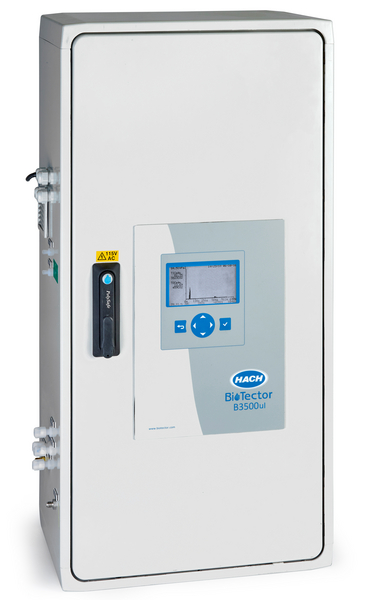
Hach BioTector B3500ul TOC Analyzer
Hach BioTector B3500ul TOC Analyzer is the ultimate TOC monitoring solution for Ultrapure Water. As a leading total organic carbon (TOC) analyzer, it ensures precise TOC results, surpassing benchtop TOC analyzer standards. Renowned among TOC analyzer manufacturers, this instrument's advanced oxidation technology guarantees thorough oxidation. B3500ul stands out as the reliable choice for monitoring water contaminants at ppb levels, safeguarding equipment and optimizing treatment decisions.
Applications: Energy Supply, Ultra-Pure Water
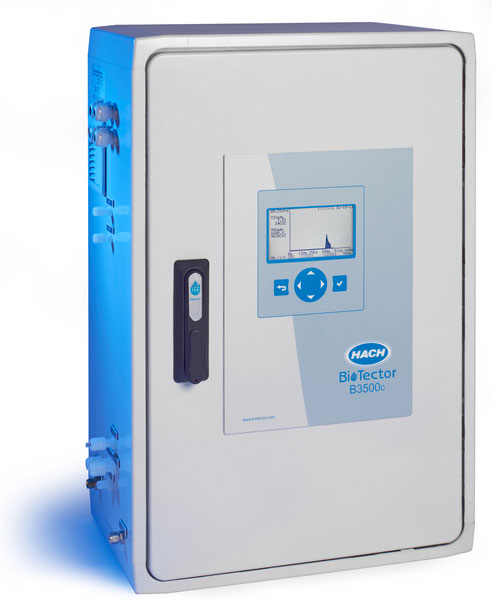
Hach BioTector B3500c Online TOC Analyzers
Using patented technology only requires scheduled maintenance every 6 months, allowing for dual stream monitoring, and having one of the most compact analyzer footprints, the Hach TOC BioTector B3500c delivers 99.86% uptime in condensate applications with the lowest operating cost.
Applications: Condensate Return, Cooling Water, Boiler Feed Water, Demineralized Water, Reverse Osmosis Water, Carbon Bed Absorber

Hach BioTector B3500dw TOC Analyzer
The B3500dw TOC Analyzer system routinely checks raw and finished water quality every 6.5 minutes, calculating, and displaying the percentage removal of contaminants. This real-time monitoring aids in predicting potential maximum contamination level breaches, ensuring that plant operators are always ahead of any potential compliance issues. The instrument allows them to make timely process adjustments, ensuring consistent water quality regardless of changes in the incoming water supply. Additionally, by monitoring and regulating naturally occurring organics through TOC analysis, the system also optimizes usage, balancing both water quality and cost. Its high uptime and dependability mean it seamlessly integrates into standard plant management processes.
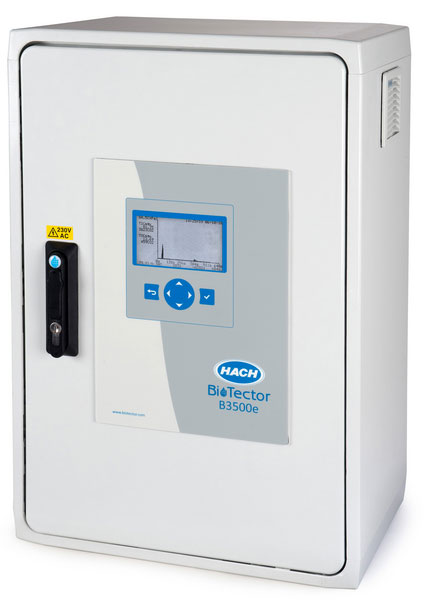
Hach BioTector B3500e TOC Analyzers
The Hach B3500e TOC Analyzer is tailor-made for monitoring final wastewater effluent and discharges to meet TOC requirements in water regulations. Being a regulatory compliant will save you a significant penalty cost while protecting the local environment.
Applications: Industrial wastewater treatment plant effluent, Discharge control, Rainwater/river water, Ground/surface water

Hach B7000i Online TOC Analyzers
Hach B7000i TOC Analyzer comes with a built-in self-cleaning sample line and reactor. This enables the B7000i to deliver trustworthy results even if your water contains high levels of fats, oils, greases, sludge, and particulates or has pH swings.
Applications: Industrial Wastewater Treatment Plant Influent and Effluent, Process Water, Product Loss Control, Oil in Water
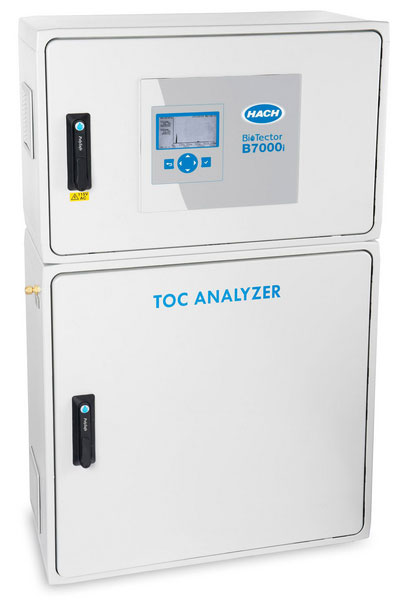
B7000i Dairy Online TOC Analyzer
Industry studies show that lost products can be reduced by over 15% in Dairy Processing Plants by using accurate, reliable, and continuous TOC measurement. Further savings of up to 40% can be made in the operating cost of the treatment plant by reducing energy and water consumption.
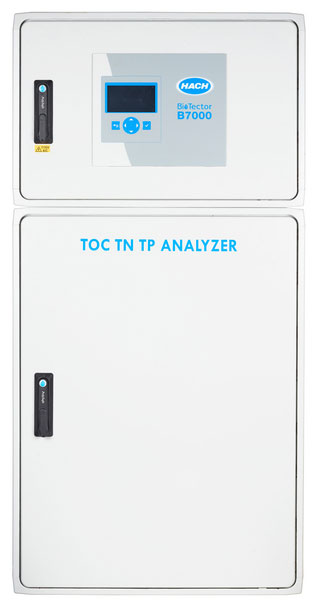
B7000 Online TOC/TN/TP Analyzer
Hach B7000 TOC Analyzer provides a single analyzer for carbon contamination and nitrogen/ phosphorus nutrient levels in the water. The mechanism significantly captures changes in water quality with direct analysis of Total Organic Carbon (contamination), Total Nitrogen, and Total Phosphorus in the most challenging samples.
BioTector Online TOC Analyzer Walk-Through Video
Product features
- Intelligent design - oversized sample tubing handles even the most challenging applications, including limited amounts of fats, oil, and grease (FOG)
- Advanced functionality - direct reporting of % removal (B3500dw), and reporting of TOC correlated parameters such as BOD and COD
- Powerful sample breakdown - patented Two-Stage self-cleaning oxidation technology (TSAO) is 40% more effective at oxidizing samples than analyzers.
- Low cost of ownership - designed for continuous operation, the TOC BioTector requires part replacement only twice a year in many applications.
- Superior reliability - typically 99.86% uptime enables plants to leverage results for continuous process control.
- Worldwide service and support through Hach with installations at leading manufacturers around the world
With reliable, continuous environmental monitoring and real-time process control, Hach BioTector analyzers allow plants to optimize processes by decreasing chemical dosing, minimizing waste and reducing manual sample processes and costs.
Hach testing instruments work with utmost accuracy and precision that drives confidence in testing results, and our Total Organic Carbon (TOC) BioTectors provide maximum uptime.
Accurate Organics Measurement
B3500c, B3500e, B7000i, B7000 models are reliable and are well equipped to handle difficult samples without burdening you with maintenance responsibilities.
With options for clean water application and even the most challenging applications involving fats, oils, greases, salts, sludge, and particulates, Hach’s TOC Analyzers provide accurate results at the lowest operating costs.
- Employs a two-step oxidation method similar to B7000
- B3500ul cooling water, RO water, etc. (low concentration model: 0-5ppm)
- B3500c Collected water, discharged water, etc. (standard model: 0-25ppm, option: 0-100ppm)
- B3500e industrial wastewater, etc. (high concentration model: 0-250ppm, option: 0-1,000ppm)
- Optional samplers, sample pots, service parts kits, etc.
Frequently Asked Questions
What Is TOC or Total Organic Carbon and why is it measured?
TOC analysis measures organic contamination levels (organic load) - a crucial indicator of general water quality and as control for water treatment processes.
TOC responds to all organic types, either dissolved or suspended in water, even if containing oil, fats, greases, salts, particulates or high sulphur levels.
TOC (Total Organic Carbon) is a crucial parameter for water quality analysis. It helps in determining the amount of organic carbon present in each sample of water.
The measurement of TOC is vital for assessing water quality and ensuring its safety. By analyzing TOC levels, it becomes possible to evaluate the presence of organic matter and potential contaminants in water sources. This information is particularly significant for applications where the purity of water is essential.
TOC analyzers, instruments specifically designed for TOC analysis, are used to measure, and calculate TOC levels accurately. These analyzers employ various methods to determine total organic carbon in water samples. The TOC principle involves the oxidation of organic carbon compounds, followed by the detection and quantification of the resulting carbon dioxide.
By utilizing TOC analysis, professionals can assess water quality, calculate TOC concentrations, and understand the organic carbon content in both soil and water. This information aids in monitoring environmental conditions, identifying potential contaminants, and optimizing water treatment processes.
TOC analysis has gained significance due to factors such as the Disinfection Byproduct Rules (DBPR) Stage I and II, which require increased monitoring for TOC. The awareness of disinfection byproducts and their potential health risks has emphasized the importance of measuring TOC levels in water.
Understanding the basics of organic chemistry reveals that when organic carbon combines with chlorine, it results in the formation of disinfection byproducts (DBPs). This relationship emphasizes the need for TOC analysis as a means to monitor and control the formation of DBPs, ensuring water safety.
In the event of spills or accidental releases, TOC analysis proves to be a valuable method for detecting a wide range of contaminants in water. The measurement of TOC levels provides an effective means to identify and assess the presence of various organic compounds that may have entered the water supply.
Optimization of water treatment processes is another area where TOC analysis plays a vital role.
In summary, TOC (Total Organic Carbon) is a key aspect of water quality analysis. It provides valuable insights into the organic carbon content in water samples, aiding in monitoring, assessing, and optimizing water quality for various applications.
What are the Organics Measurement Methods?
Biological oxygen demand (BOD) and chemical oxygen demand (COD) are commonly used to indirectly measure organics, but it takes five days to test BOD and several hours for COD. Lab TOC analysis directly measures organics but without continuous readings, it is difficult for facilities to optimize treatments or detect product loss. Only online TOC analysis provides quantifiable product loss detection and helps protect capital equipment. Many TOC analysers won’t hold up in the harsh conditions of food and dairy processing. However, the B7000 uses patented two stage advanced oxidation (TSAO) technology and larger internal diameter tubing (with self-cleaning), giving the B7000 the ability to measure organics reliably in food processing conditions with 99.86% uptime and required preventative maintenance only twice per year.
With the ability to monitor two streams, the B3500c is ideal for clean water, such as condensate applications. Facilities can continuously monitor condensate return lines for organics to facilitate water reuse. When TOC is high, systems can divert the condensate to protect equipment, alarm staff to look for leaks, and track TOC data for process improvement.
Can the BioTector TOC analyzers handle high sulfate levels?
Many TOC analyzers will have a hard time with high levels of sulfates. BioTector actually uses 1.8 N H2SO4 and 6 N H2SO4 reagents which means that the BioTector will not have a problem with measuring sulfates.
What phases are involved in The TSAO Technology?
Patented two-stage oxidation with hydroxyl radicals, ensures complete oxidation of the sample.
First phase
- ToC stripped by adding acid.
- The resulting CO2 is measured in the IR detector.
- Important: The ToC stripping is controlled by the CO2 curve, which ensures that all the ToC is stripped.
Second Phase
- TOC converted into carbonates and oxalates by adding ozone and lye.
- Carbonates and oxalates converted into CO2 by re-adding acid.
- The resulting CO2 is measured in the IR detector.
The online total organic carbon (TOC) analyzer BioTector series is a TOC analyzer uses the “two-step oxidation method" with strong oxidizing power. In addition, the energy cost is 1/5 or less compared to a general combustion-type TOC meter, contributing to the realization of SDGs.
What is the Importance of Monitoring Organics?
All food sources have an organic component. Monitoring organics in water and drain lines helps production facilities quickly and accurately measure the carbon content in their water streams so they can:
- Maximise production yield by quickly detecting product loss events to take corrective actions and improve production management processes to prevent future product loss.
- Mitigate compliance risks by addressing biological treatment overload, irregularities in operations, and inefficient chemical feed in the wastewater treatment process. Food production facilities can save energy, reduce chemical consumption, and generate less solid waste while consistently meeting regulation requirements.
- Protect capital equipment by reducing corrosion, leaks,fouling, maintenance, and downtime. Organics in condensate will cause organic acid formation, leading to corrosion of the boiler and damage to valuable assets.
The BioTector TOC Analysers help facilities run more efficiently by measuring organics in minutes to diagnose product loss, optimise treatments, improve process control, protect capital equipment, and most of all ensure compliance.
Can the Biotector measure COD?
Yes, via lab correlation
Can I use the Biotector to calculate product loss?
Since the Biotector measures TOC, a total sum parameter of carbon compounds present, this can be used to calculate product loss.
Does the Biotector have a self cleaning function?
The entire system is automatically self-cleaned by the reaction process during every cycle.
Can I measure anything other than TOC?
The Biotector B7000 can directly measure TOC, TC, IC, VOC, TN, TP as well as BOD and COD via correlation.
Can I use the Biotector to monitor NOM in drinking water applications?
The Hach BioTector ® B3500dw Online TOC Analyzer , which is developed specifically for the drinking water industry, optimizes the monitoring and the removal of organics based on real time TOC measurements. BioTector utilizes an advanced oxidation technology, which is a US EPA approved method, and supplies accurate and reliable detection of organics, assisting and ensuring optimal water treatment process.
How often do I need to maintain the instrument?
HACH recommends a six monthly service and maintenance schedule which is typically conducted by factory trained HACH service technicians.
Can the Biotector handle high salt levels?
The Hach B700i is designed and tested to handle up to 30% w/v salt levels.
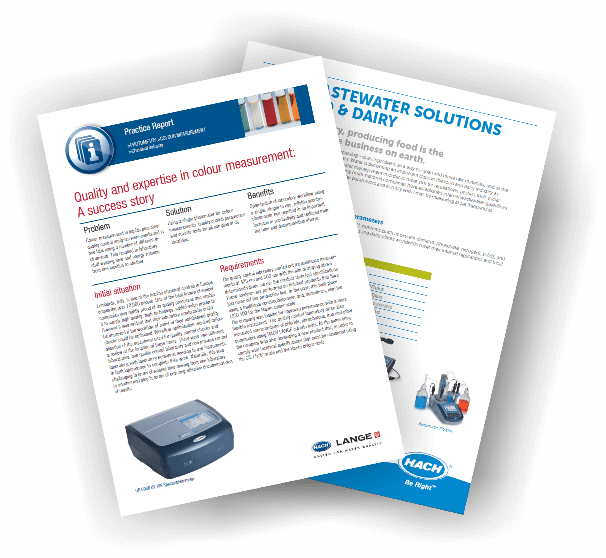
Knowledge Center
Check out our extensive resource library to address your water analysis challenges. Here are few hand-picked ones for your learning. Find out more on each product page for a wide variety of application notes, case studies, manuals, and guides.
PRODUCT SUPPORT
CUSTOMER SERVICE
RESOURCES
ABOUT US
Looking for our Hach US Site?
It appears that you are visiting Hach from the United States but the site you are currently visiting is for Malaysia.
Would you like to visit the Hach US site instead?



